Desision Making In Java
Decision Making in Java (if, if-else, switch, break, continue, jump)
Decision Making in programming is similar to decision making in real life. In programming also we face some situations where we want a certain block of code to be executed when some condition is fulfilled.A programming language uses control statements to control the flow of execution of program based on certain conditions. These are used to cause the flow of execution to advance and branch based on changes to the state of a program.
Java’s Selection statements:
if:
if statement is the most simple decision making statement. It is used to decide whether a certain statement or block of statements will be executed or not i.e if a certain condition is true then a block of statement is executed otherwise not.Syntax:
if(condition)
{
// Statements to execute if
// condition is true
}
|
Flow chart:
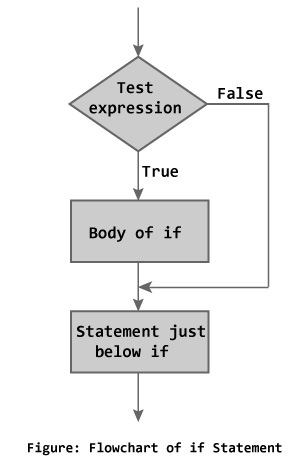
Here, condition after evaluation will be either true or false. if statement accepts boolean values – if the value is true then it will execute the block of statements under it. If we do not provide the curly braces ‘{‘ and ‘}’ after if( condition ) then by default if statement will consider the immediate one statement to be inside its block.
For example
if(condition) statement1; statement2; |
if-statement-in-java
Example:
// Java program to illustrate If statement
class IfDemo
{
public static void main(String args[])
{
int i = 10;
if (i > 15)
System.out.println("10 is less than 15");
// This statement will be executed
// as if considers one statement by default
System.out.println("I am Not in if");
}
}
|
Output:
I am Not in if |
if-else:
The if statement alone tells us that if a condition is true it will execute a block of statements and if the condition is false it won’t. But what if we want to do something else if the condition is false. Here comes the else statement. We can use the else statement with if statement to execute a block of code when the condition is false.Syntax:
if (condition)
{
// Executes this block if
// condition is true
}
else
{
// Executes this block if
// condition is false
}
|
Flow chart:
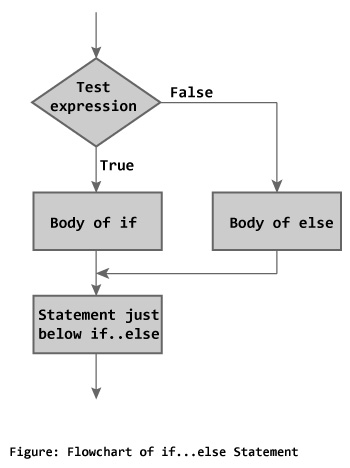
if-else-statement
Example:
// Java program to illustrate if-else statement
class IfElseDemo
{
public static void main(String args[])
{
int i = 10;
if (i < 15)
System.out.println("i is smaller than 15");
else
System.out.println("i is greater than 15");
}
}
|
Output:
i is smaller than 15 |
nested-if:
A nested if is an if statement that is the target of another if or else. Nested if statements means an if statement inside an if statement. Yes, java allows us to nest if statements within if statements. i.e, we can place an if statement inside another if statement.Syntax:
if (condition1)
{
// Executes when condition1 is true
if (condition2)
{
// Executes when condition2 is true
}
}
|
Flow chart:
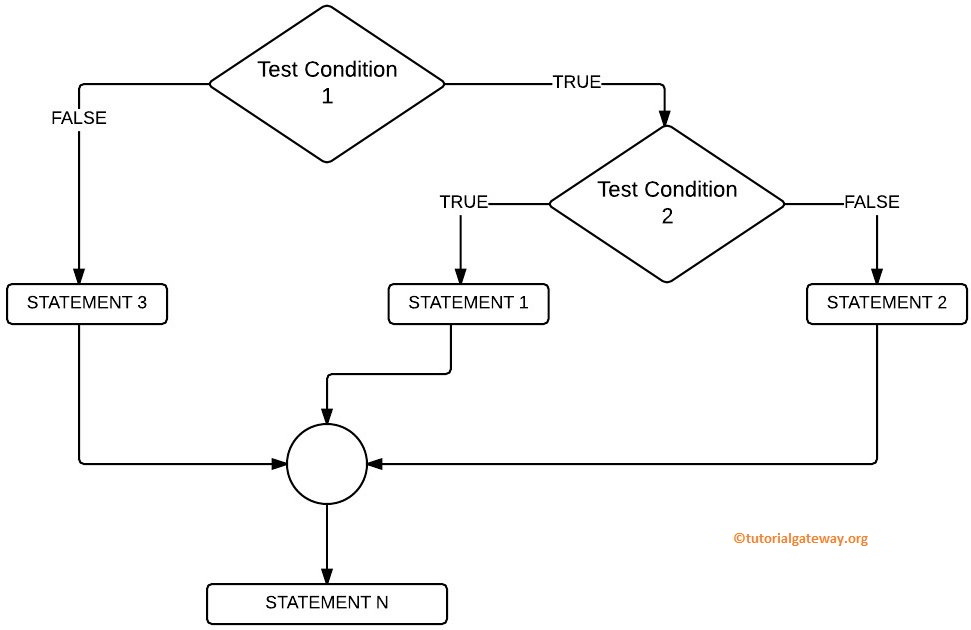
nested-if
Example:
// Java program to illustrate nested-if statement
class NestedIfDemo
{
public static void main(String args[])
{
int i = 10;
if (i == 10)
{
// First if statement
if (i < 15)
System.out.println("i is smaller than 15");
// Nested - if statement
// Will only be executed if statement above
// it is true
if (i < 12)
System.out.println("i is smaller than 12 too");
else
System.out.println("i is greater than 15");
}
}
}
|
Output:
i is smaller than 15 i is smaller than 12 too |
if-else-if ladder:
Here, a user can decide among multiple options.The if statements are executed from the top down. As soon as one of the conditions controlling the if is true, the statement associated with that if is executed, and the rest of the ladder is bypassed. If none of the conditions is true, then the final else statement will be executed.
if (condition)
statement;
else if (condition)
statement;
.
.
else
statement;
if-else-if-ladder
|
Flow chart:

Example:
// Java program to illustrate if-else-if ladder
class ifelseifDemo
{
public static void main(String args[])
{
int i = 20;
if (i == 10)
System.out.println("i is 10");
else if (i == 15)
System.out.println("i is 15");
else if (i == 20)
System.out.println("i is 20");
else
System.out.println("i is not present");
}
}
|
Output:
i is 20 |
switch-case:
The switch statement is a multiway branch statement. It provides an easy way to dispatch execution to different parts of code based on the value of the expression.Syntax:
switch (expression)
{
case value1:
statement1;
break;
case value2:
statement2;
break;
.
.
case valueN:
statementN;
break;
default:
statementDefault;
}
|
Flow chart:
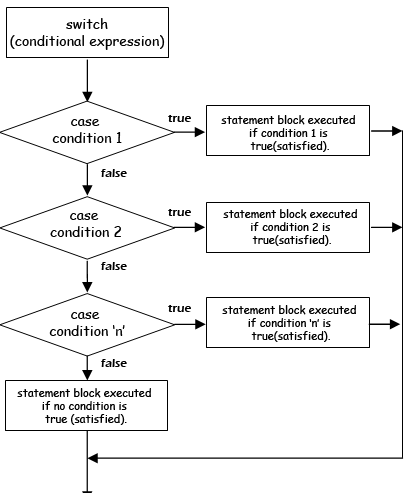
switch-case-in-java
Example:
// Java program to illustrate switch-case
class SwitchCaseDemo
{
public static void main(String args[])
{
int i = 9;
switch (i)
{
case 0:
System.out.println("i is zero.");
break;
case 1:
System.out.println("i is one.");
break;
case 2:
System.out.println("i is two.");
break;
default:
System.out.println("i is greater than 2.");
}
}
} |
Output:
i is greater than 2. |
1.Break:
In Java, break is majorly used for:Using break to exit a Loop
Using break, we can force immediate termination of a loop, bypassing the conditional expression and any remaining code in the body of the loop.Note:
Break, when used inside a set of nested loops, will only break out of the innermost loop.Flow chart:
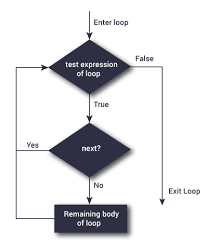
using-break-to-exit-a-loop-in-java
Example:
// Java program to illustrate using // break to exit a loop
class BreakLoopDemo
{
public static void main(String args[])
{
// Initially loop is set to run from 0-9
for (int i = 0; i < 10; i++)
{
// terminate loop when i is 5.
if (i == 5)
break;
System.out.println("i: " + i);
}
System.out.println("Loop complete.");
}
}
|
Output:
i: 0 i: 1 i: 2 i: 3 i: 4 Loop complete. |
Using break as a Form of Goto
Java does not have a goto statement because it provides a way to branch in an arbitrary and unstructured manner. Java uses label. A Label is use to identifies a block of code.Syntax:
label:
{
statement1;
statement2;
statement3;
.
.
}
|
Note:
You cannot break to any label which is not defined for an enclosing block.Syntax:
break label; |
Example:
// Java program to illustrate using break with goto
class BreakLabelDemo
{
public static void main(String args[])
{
boolean t = true;
// label first
first:
{
// Illegal statement here as label second is not
// introduced yet break second;
second:
{
third:
{
// Before break
System.out.println("Before the break statement");
// break will take the control out of
// second label
if (t)
break second;
System.out.println("This won't execute.");
}
System.out.println("This won't execute.");
}
// Third block
System.out.println("This is after second block.");
}
}
}
|
Output:
Before the break. This is after second block. |
2.Continue:
Sometimes it is useful to force an early iteration of a loop. That is, you might want to continue running the loop but stop processing the remainder of the code in its body for this particular iteration. This is, in effect, a goto just past the body of the loop, to the loop’s end. The continue statement performs such an action.Flow chart:

continue-in-java
Example:
// Java program to illustrate using // continue in an if statement
class ContinueDemo
{
public static void main(String args[])
{
for (int i = 0; i < 10; i++)
{
// If the number is even
// skip and continue
if (i%2 == 0)
continue;
// If number is odd, print it
System.out.print(i + " ");
}
}
}
|
Output:
1 3 5 7 9 |
Return:
The return statement is used to explicitly return from a method. That is, it causes a program control to transfer back to the caller of the method.Example:
// Java program to illustrate using return
class Return
{
public static void main(String args[])
{
boolean t = true;
System.out.println("Before the return.");
if (t)
return;
// Compiler will bypass every statement
// after return
System.out.println("This won't execute.");
}
}
|
Before the return. |
« Previous Next »